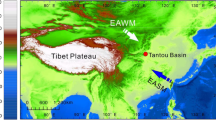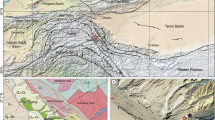Abstract
The Early–Middle Eocene palynoflora and paleoclimate of Changchang Basin, Hainan Island, South China, is described in the present paper and is compared with that of the Middle–Late Eocene, Hunchun City, Jilin Province, North China. The nearest living relatives (NLRs) of the recovered palynotaxa suggest a subtropical evergreen or deciduous broad-leaved forest at the center of the basin but a temperate evergreen or deciduous broad-leaved forest and needle-leaved forest growing in the peripheral part of the basin. Based on the climatic preferences of the NLRs, the climate in the Changchang Basin during the Early–Middle Eocene was warm and humid subtropical with a mean annual temperature of 14.2–19.8°C, a mean temperature of the warmest month of 22.5–29.1°C, a mean temperature of the coldest month of 1.7–11.9°C, a difference of temperature between coldest and warmest months of 12.1–24.6°C, a mean annual precipitation of 784.7–1,113.3 mm, a mean maximum monthly precipitation of 141.5–268.1 mm and a mean minimum monthly precipitation of 6.9–14.1 mm. A comparison of the palynoflora and paleoclimate between the Changchang Basin and Hunchun City, suggests essentially a similar climate in South and North China during Eocene time in contrast to the oceanic tropical climate in South China and cool dry temperate climate in North China as at present.
Similar content being viewed by others
References
CCPGCCAS (Compilation Committee of Physical Geography of China, Chinese Academy of Sciences) (1984) Physical geography of China, vol. 1. Science, Beijing, pp 1–63 (in Chinese)
CCVC (Compilation Committee of Vegetation of China) (1995) Vegetation of China. Science Press, Beijing, pp 61–82 (in Chinese)
Christopher et al (2007) Plant species distributions under present conditions and forecasted for warmer climates in an arid mountain range. Earth Interact 11(Paper No. 9):1–33
Deniz IG, Sümbül H (2004) Flora of the Elmali Cedar Research Forest (Antalya/Turkey). Turk J Bot 28:529–555
Guo SX (1979) Late Cretaceous and Early Tertiary floras from the southern Guangdong and Guangxi with their stratigraphic significance. In: Institute of Vertebrate Palaeontology and Palaeoanthropology, Nanjing Institute of Geology and Palaeontology. Academia Sinica (eds) Mesozoic and Cenozoic red beds of South China. Science Press, Beijing, pp 223–230 (in Chinese)
Harris N (2006) The elevation history of the Tibetan Plateau and its implications for the Asian monsoon. Paleogeogr Paleoclimatol Paleoecol 241:4–15
Heshmati (2007) Vegetation characteristics of four ecological zones of Iran. Int J Plant Prod 2:215–224
IDBMC (Information Department of Beijing Meteorological Center) (1983a) Land climate data of China (I) (1951–1980). Meteorology Press, Beijing, pp 4–5, 86–87 (in Chinese)
IDBMC (Information Department of Beijing Meteorological Center) (1983b) Land climate data of China (VI) (1951–1980). Meteorology Press, Beijing, pp 4–6, 126–128 (in Chinese)
IDBMC (Information Department of Beijing Meteorological Center) (1983c) Land climate data of China (II) (1951–1980). Meteorology Press, Beijing, pp 4–5, 72–73 (in Chinese)
IDBMC (Information Department of Beijing Meteorological Center) (1984a) Land climate data of China (III) (1951–1980). Meteorology Press, Beijing, pp 4–6, 107–109 (in Chinese)
IDBMC (Information Department of Beijing Meteorological Center) (1984b) Land climate data of China (IV) (1951–1980). Meteorology Press, Beijing, pp 4–6, 99–101 (in Chinese)
IDBMC (Information Department of Beijing Meteorological Center) (1984c) Land climate data of China (V) (1951–1980). Meteorology Press, Beijing, pp 4–6, 108–110 (in Chinese)
Jin JH et al (2002) Palaeodiversification of the environment and plant community of Tertiary in Hainan Island. Acta Ecol Sin 22(3):425–432 (in Chinese with English abstract)
Jose et al (1994) Range assessment using remote sensing in Northwest Patagonia (Argentina). J Range Manag 47(6):498–502
Karemy ZAR, Zayed KM (1992) The vegetation and habitat types of Baha Plateau (Saudi Arabia). J Islamic Acad Sci 5(4):256–264
Kou XY (2005) Studies on quantitative reconstruction of Cenozoic climates in China by palynological data. Ph.D. thesis, Institute of Botany, the Chinese Academy of Science, Beijing, China, pp 46–55 (in Chinese with English abstract)
Kou XY et al (2006) The reconstruction of paleovegetation and paleoclimate in the Late Pliocene of West Yunnan, China. Clim Change 77(3–4):431–448
Lei ZQ (1985) Tertiary sporo-pollen assemblage of Zhujiangkou (Pearl River North) Basin and its stratigraphical significance. Acta Bot Sin 27(1):94–10 (in Chinese with English abstract)
Lei YZ et al (1992) Tertiary. In: Yichang Institute of Geology and Mineral Resources, Bureau of Geology and Mineral Resources of Hainan (eds) Geology of Hainan Island (I): stratigraphy and palaeontology. Geological Publishing House, Beijing, pp 1–281 (in Chinese)
Li MY (1989) Sporo-pollen from Shanghu Formation of Early Paleocene in Nanxiong Basin, Guangdong. Acta Palaeontol Sin 28(6):741–749 (in Chinese with English abstract)
Li MY, Qing GR (1994) Paleocene sporopollen from the Buxin Group of the Longgui Basin, Guangdong. Acta Micropalaeontol Sin 11(1):55–69 (in Chinese with English abstract)
Li XQ, Du NQ (1999) The acid–alkali-free analysis of Quaternary pollen. Acta Bot Sin 41(7):782–784 (in Chinese with English abstract)
Mabberley DJ (1997) The plant-book: a portable dictionary of the vascular plants, 2nd edn. Cambridge University Press, UK, pp 1–858
McGinley (2007) Central Asian southern desert. http://www.eoearth.org/article/Central_Asian_southern_desert. Cited 22 Dec 2007
Moore PD, Webb JA (1978) An illustrated guide to pollen analysis. Hodder and Stoughton, London, pp 5–50
Moore PD et al (1991) Pollen analysis, 2nd edn. Blackwell, London, pp 191
Mosbrugger V, Utescher T (1997) The coexistence approach: a method for quantitative reconstructions of Tertiary terrestrial palaeoclimate data using plant fossil. Paleogeogr Paleoclimatol Paleoecol 134:61–86
Peck RM (1974) A comparison of four absolute pollen preparation techniques. New Phytol 73:567–587
Rea DK et al (1990) Global change at the Paleocene–Eocene boundary: climatic and evolutionary consequences of tectonic events. Paleogeogr Paleoclimatol Paleoecol 79:117–128
Sloan LC, Barron EJ (1992) A comparison of Eocene climate model results to quantified paleoclimatic interpretations. Paleogeogr Paleoclimatol Paleoecol 93:183–202
Sloan LC, Rea DK (1995) Atmospheric CO2 of the Early Eocene: a general circulation modeling sensitivity study. Paleogeogr Paleoclimatol Paleoecol 119:275–292
Sloan LC et al (2001) Effect of sea surface temperature configuration on model simulations of “equable” climate in the Early Eocene. Paleogeogr Paleoclimatol Paleoecol 167:321–335
Song ZC et al (1999) Fossil spores and pollen of China, vol 1: the Late Cretaceous and Tertiary spores and pollen. Science Press, Beijing, pp 1–910 (in Chinese with English abstract)
Spjeldnaes N (1973) Comments on 4.1 “The primary cause of ice age”. In: Tarling DH, Runcorn SK (eds) Implication of continental drift to the earth sciences, vol I. Academic, London, p 450
Sun XJ et al (1981) Spores and pollen. In: South Sea Branch of Petroleum Corporation of the People’s Republic of China et al (eds) Tertiary palaeontology of north continental shelf of South China Sea. Guangdong Science and Technology Press, Guangzhou, pp 1–58 (in Chinese)
Sun XJ et al (1982) Palynoflora of the Liushagang Formation (Eocene–Early Oligocene) in the northern part of South China Sea. Acta Phytotaxon Sin 20(1):63–71 (in Chinese with English abstract)
Sun MR et al (1989) Spore and pollen. In: Research Party of Marine Geology, Ministry of Geology and Mineral Resources Institute of Geology Chinese Academy of Geological Science (ed) Cenozoic paleobiota of the continental shelf of the East China Sea (Donghai) (micropaleobotanical volume). Geological Science Press, Beijing, pp 6–40 (in Chinese)
The Deserts of North America. http://instruct.uwo.ca/biology/320y/namdes.html. Cited 22 Dec 2007
Wu ZY (1991) The areal-types of Chinese genera of seed plants. Acta Bot Yunnan (suppl.) IV:1–139 (in Chinese with English abstract)
Wu ZY, Ding TY (1999) Seed plants of China. Yunnan Science and Technology Press, Kunming (Electronic publication in Chinese)
Wu ZJ, Yu JF (1981) Late Paleocene spores and pollen grains from the uppermost part of Nongshan group in Nanxiong Basin, Guangdong. Acta Palaeontol Sin 20(5):442–448 (in Chinese with English abstract)
Wu ZY et al (2003) The areal-types of the world families of seed plants. Acta Bot Yunnan 25(3):245–257 (in Chinese with English abstract)
Xu JX et al (2000) A method for quantitative reconstruction of Tertiary palaeoclimate and environment—coexistence approach. In: Li CS (ed) Advances in plant science, vol 3. China Higher Education Press, Beijing and Springer, Heidelberg, pp 195–203 (in Chinese)
Yu JF (1983) A study on the Late Eocene–Early Oligocene microflora of Fu-1 borehole, Fushan, Hainan Island. Trop Oceanol 2(1):1–10 (in Chinese with English abstract)
Zhang QR (1980) Stratigraphy and palaeontology. Yichang Institute of Geology and Mineral Resources, Chinese Academy of Geology Sciences, Yichang, pp 106–117 (in Chinese)
Zhang YY (1981) Tertiary spores and pollen grains from the Leizhou Peninsula. Acta Micropalaeontol Sin 20(5):449–458 (in Chinese with English abstract)
Zhang YY et al (1990) Eocene palynoflora from the southwestern continental shelf basin of the East China Sea. Acta Micropalaeontol Sin 7(4):389–402 (in Chinese with English abstract)
Zhang KJ et al (1998) Did the Indo-Asian collision alone create the Tibetan Plateau; discussion. Geology 26:958
Author information
Authors and Affiliations
Corresponding authors
Rights and permissions
About this article
Cite this article
Yao, YF., Bera, S., Ferguson, D.K. et al. Reconstruction of paleovegetation and paleoclimate in the Early and Middle Eocene, Hainan Island, China. Climatic Change 92, 169–189 (2009). https://doi.org/10.1007/s10584-008-9457-2
Received:
Accepted:
Published:
Issue Date:
DOI: https://doi.org/10.1007/s10584-008-9457-2




